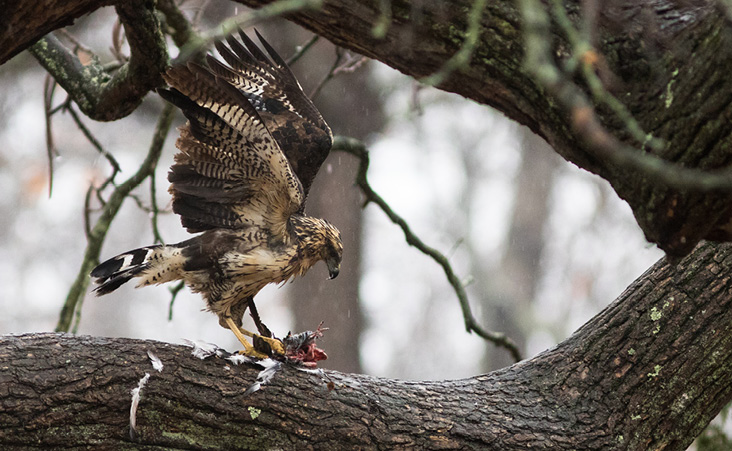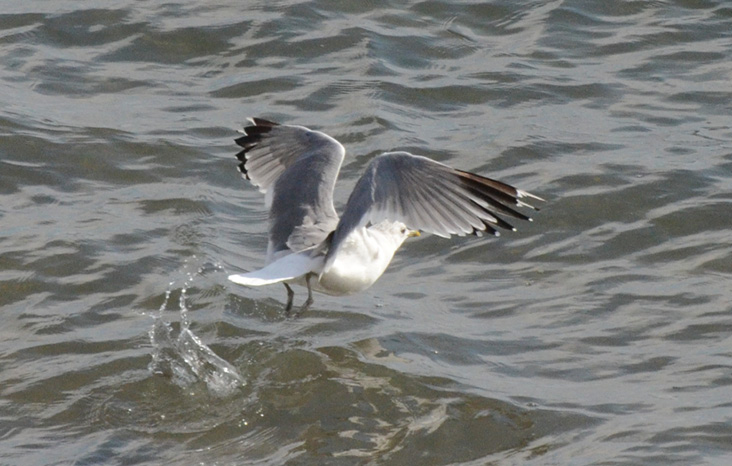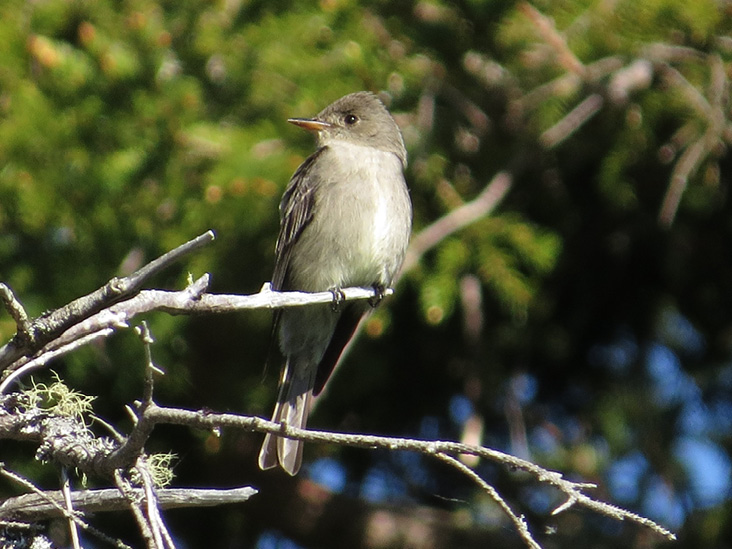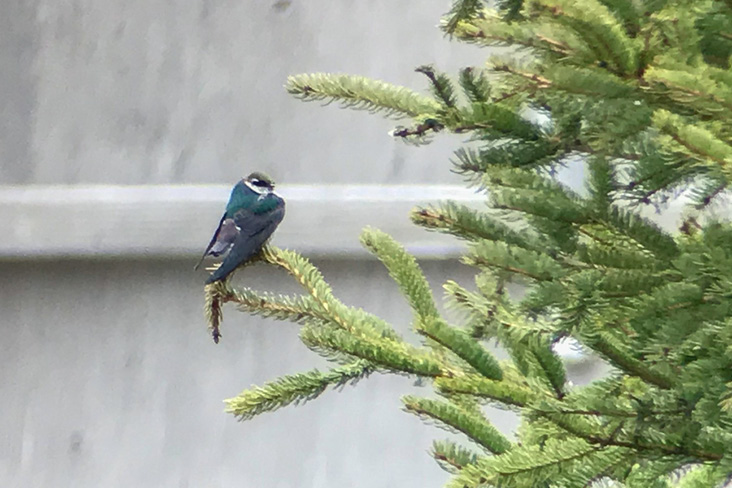Douglas P. Hitchcox, Tom Aversa, Louis R. Bevier, and Trevor B. Persons

Great Black Hawk, a first for Maine, found in Biddeford on August 6-9, 2018, was apparently the same individual found in Texas on April 24, 2018, representing the first United States record. It later was relocated in Portland where thousands of onlookers visited during the bird's eight-week stay. Photograph by Doug Hitchcox.
This 8th report of the Maine Bird Records Committee (hereafter ME-BRC or the committee) summarizes the assessment of 57 reports involving 27 species. Evaluation of and decisions by the committee for these reports occurred during 2018. The committee accepted 44 records for an acceptance rate of 77%. Although the majority of birds in this report were documented in 2017–2018, the years of occurrences range from 1988 to 2018.
Highlights in this report include six species accepted as documented for the first time in the state of Maine: Roseate Spoonbill, Great Black Hawk, Western Wood-Pewee, Gray Flycatcher, Cassin's Vireo, and Violet-green Swallow. In addition, the first state record for Swainson's Warbler, previously unreviewed but accepted provisionally, is accepted here. These bring the total number of accepted species on Maine's state list to 462. The official list of bird species recorded in Maine, our review procedures, and members can be found at the committee's website: https://sites.google.com/site/mainebirdrecordscommittee
Records in this report are grouped by species, with both those accepted and those not accepted listed within the same species account. Each account provides the location, county (italicized), date(s) of occurrence, names of observers or contributors, and committee record number. Observers listed are those providing documentation to the committee, or in some cases, documentation harvested from publicly published websites. All reviewed materials and member comments are archived. If known, the names of finders are listed first and separated from other names by a semicolon. Photographic, video, or audio evidence reviewed is denoted by a dagger (†); written notes are denoted by an asterisk (*). As always, the committee strongly encourages written submissions even when there are photographs. Species accounts follow the current taxonomic classification and sequence adopted as of 2018 by the American Ornithological Society (list available at http://checklist.aou.org/taxa/).
Species Accounts
Ross's Goose (Anser rossii). An adult spent three days in Fort Fairfield, Aroostook, September 28–30, 2017 (Bill Sheehan†; Steve Mierzykowski†, Josh Fecteau†, Louis Bevier*; 2017-036).
Pink-footed Goose (Anser brachyrhynchus). A pair was present in Rockland, Knox, January 2–February 8, 2017, then a single bird continued through April 3, 2017. (Don Reimer†; Louis Bevier†, Rob Speirs†, Magill Weber†, Charlie Todd†; 2017-001). One was found September 26, 2017, at Collins Pond, Caribou, Aroostook, then at a private pond in northern Presque Isle, Aroostook, October 4, 2017, and again at Caribou on October 7, 2017 (Bill Sheehan†; 2017-035). Another bird was found nine days later on October 16, 2017, at Mars Hill Pond, Aroostook (Nancy Houlihan†, Pat Moynahan; 2017-045); photographs were not helpful for comparing to 2017-035 and some members felt this should be treated as the same bird. NOT ACCEPTED, IDENTIFICATION QUESTIONED: The committee questioned whether a brief in-flight sight record from Readfield, Kennebec, on April 8, 2017, (2017-017) was seen well enough to be positively identified.
Garganey (Spatula querquedula). Maine's second record, first reported by Perkins (1999), was a male seen by many observers at Weskeag Marsh in South Thomaston, Knox, September 10–18, 1999 (Chris Hepburn*, Don Crockett†; 1999-002).
Rufous or Allen's Hummingbird (Selasphorus rufus or sasin). An immature male Selasphorus hummingbird visited a feeder in Portland, Cumberland, October 20–24, 2016 (Carole Jean; Doug Hitchcox†, Louis Bevier†; 2016-030). Although the committee rejected the record as definitively representing Rufous Hummingbird, it accepted it as Rufous/Allen's.
Long-tailed Jaeger (Stercorarius longicaudus). Six reports involving eight first-summer individuals were endorsed by the committee. The last bird from a flock of three off Bar Harbor, Hancock, July 21, 2017, was accepted as this species (Kyle Lima†; 2017-024)—the other two had been accepted in our 7th report (Bevier 2018). A single was off Bar Harbor, Hancock, July 13, 2018 (Robert Ostrowski*†; 2018-022). Another flock of three flew by Mount Desert Rock, Hancock, July 26, 2018 (Nathan Dubrow*†; 2018-023). Finally singles were recorded off Bar Harbor, Hancock, August 6, 2018 (Brent Boncamp *†; 2018-028), Mount Desert Rock, Hancock, August 25, 2018 (Nathan Dubrow*†; 2018-030), and on the water at Two Lights State Park, Cape Elizabeth, Cumberland, September 1, 2018 (Glenn Hopkins†; 2018-035).
Ancient Murrelet (Synthliboramphus antiquus). Presumably recurring from 2016, this bird was first photographed on May 21, 2017, in the waters around Machias Seal Island, Washington (Kyle Lima†), one of three locations where it was seen in 2016. Three days later it was found 100 miles west-southwest at Matinicus Rock, Knox, on May 24, 2017. (John Drury†; 2017-013). An Ancient Murrelet found at Seal Island National Wildlife Refuge, Knox, seven miles northwest of Matinicus Rock, on June 6, 2018, (Keenan Yakola†; 2018-014) was accepted as a new record, but the odds are good that this bird was the same returning individual.
Franklin's Gull (Leucophaeus pipixcan). An adult in basic plumage was photographed at Wharton Point in Brunswick, Cumberland, November 6, 2017 (Gordon Smith†; 2017-048). NOT ACCEPTED, IDENTIFICATION QUESTIONED: Distant photos of an adult dark-headed gull off Criehaven, Knox, on June 3, 2018 (2018-013), the committee thought did not rule out an adult Laughing Gull.

Mew Gull showing field marks consistent with L. c. canus, found in Eastport, February 10-15, 2018. Photograph by Chris Bartlett.
Mew Gull (Larus canus). An adult identified as the nominate European subspecies L. c. canus (Common Gull) was seen sporadically February 10–15, 2018, at Eastport, Washington (Chris Bartlett†; 2018-001).
Sandwich Tern (Thalasseus sandvicensis). An adult first seen at Pond Island National Wildlife Refuge, Sagadahoc, August 3, 2018 was photographed the following day. (Will Kennerley†; 2018-025). NOT ACCEPTED, IDENTIFICATION QUESTIONED: Despite the close association with the above record, the committee felt a sight report of a bird seen during a whale watch off Boothbay, Lincoln, July 18, 2018 (2018-021) was not detailed enough.
Elegant Tern (Thalasseus elegans). NOT ACCEPTED, IDENTIFICATION QUESTIONED: The description of an orange-billed tern seen at Popham Beach State Park, Phippsburg, Sagadahoc, August 15, 2016 (2016-036) was not sufficient to eliminate other species.
Pacific Loon (Gavia pacifica). Two photo-documented records were accepted: One off Pine Point, Scarborough, Cumberland, September 22–24, 2015 (Jonathan Alderfer*, Howie Nelson, Noah Gibb†; 2015-012), and one off Fortunes Rocks, Biddeford, York, May 10, 2017 (Lena Moser*, Doug Hitchcox†; 2017-011). NOT ACCEPTED, IDENTIFICATION QUESTIONED: A bird photographed off Great Wass Island, Beals, Washington, June 13, 2016, (2016-013) appeared to be an alternate plumaged Red-throated Loon (G. stellata). Sight records from West Quoddy Head, Lubec, Washington, January 21, 2017, (2017-004) off Biddeford Pool, York, January 29, 2017, (2017-005) and off Mount Desert Island, Hancock, February 19, 2018, (2018-002) were rejected due to lack of details and photo documentation for this frequently misidentified species.
Yellow-nosed Albatross (Thalassarche chlororhynchos). An obliging subadult bird sat on the rocks at the north end of Pond Island National Wildlife Refuge, Sagadahoc, for over two hours on June 18, 2017 (Shannon Carvey†; 2017-018). It was identified as the expected Atlantic-breeding nominate subspecies (or species) T. c. chlororhynchos based on its bold, triangular eye patch. Although the shape of the base of the yellow culminicorn stripe where it meets the forehead is also said to differ between Atlantic and Indian Ocean breeders (T. c. carteri), published information is conflicting. For example, Howell (2012) states it is "broader and more rounded" on carteri, whereas Marchant and Higgins (1990) describe carteri as "tapering to a fine point at base," versus "base of yellow culminicorn-stripe rounded" in chlororhynchos.
Audubon's Shearwater (Puffinus lherminieri). NOT ACCEPTED, IDENTIFICATION QUESTIONED: Although reported by two competent independent observers on July 26 and 27, 1998, (1998-001) southwest of Petit Manan Island, Hancock and Washington, the committee ultimately decided that the brevity of these sightings, both by lone observers, was not sufficient evidence to support what would be a first state record.
Brown Pelican (Pelecanus occidentalis). The committee sorted through multiple reports of this wide-ranging species, which seems to be rapidly expanding its northward wanderings. Coastal reports of immature Brown Pelican were widespread from northern Massachusetts to Maine from June 17 to August 11, 2017. At least five records were accepted by the committee. An apparent first-year bird was sighted at three locations in Saco Bay, Cumberland, June 17-23, 2017 (Ean Patry†, Tim Fennell*, Nini Pellet†, other observers, 2017-022). A pelican seen at Moody Beach, Wells, York, July 21, 2017, (Samuel Denault†; 2017-023a) was likely the same bird, but not definitively photographed so is considered a separate record. Within the same time frame, an immature was photographed at Ram Island and Higgins Beach, Scarborough, Cumberland—several miles north of Saco Bay and approximately eight coastal miles from each other (Janet Farrington†; July 22, 2017-023b). These sightings may also have pertained to the same bird. Another first-year bird was at Kennebec Point, Georgetown, Sagadahoc, August 11, 2017, (Peter Woodruff; 2017-029) and may have been the same bird, but is treated separately here. Birds of undetermined age were at Metinic Island, Knox, June 4, 2018 (Nick Ferrauolo*; 2018-020) and Seal Island National Wildlife Refuge, Knox, July 29, 2018 (Keenan Yakola†; 2018-024). NOT ACCEPTED, IDENTIFICATION QUESTIONED: Although reports at Harpswell, Cumberland, June 16, 2007 (2007-004) and Perkins Cove York, May 6, 2017 (2017-019) may have been Brown Pelicans, each lacked sufficient details.
Roseate Spoonbill (Platalea ajaja). Maine's first Roseate Spoonbill, a juvenile, was present at an infrequently birded inland location at Sebec, Piscataquis, August 27–September 9, 2018. (Dennis Peacock†, Dan Furbish; Louis Bevier†, Fyn Kind†, Margaret Viens†, Lysle Brinker†, many observers; 2018-031). This and other extralimital records of the species from the Northeast and Upper Midwest in 2018 follow an extraordinarily successful breeding season for wading birds in southern Florida. Thanks to a small hole in the maxilla, at the base of the spoon on the right side, we determined that the Maine bird was the same individual as other sightings in the Northeast during the season. It was present at Wallkill River National Wildlife Refuge, Sussex, New Jersey and Orange, New York, July 22–August 5, and after departing Maine visited coastal Connecticut at Stratford, Fairfield, and Milford, New Haven, September 15–October 5. A bird found at Saint-Martin, Quebec, on August 7 was only ~80 miles northwest of Sebec, but photographs were not good enough to determine if it was the same individual. If it was, it would constitute an impressive 370+ mile flight in two days from Wallkill River National Wildlife Refuge.
Mississippi Kite (Ictinia mississippiensis). NOT ACCEPTED, IDENTIFICATION QUESTIONED: A bird reported from Windsor, Kennebec, August 11, 2018, (2018-027) lacked sufficient details.
Great Black Hawk (Buteogallus urubitinga). One of the most unexpected birds to ever show up in Maine was a juvenile Great Black Hawk found roosting in trees in a neighborhood near Fortunes Rocks Beach, Biddeford, York, August 6–9, 2018 (Christine Murphy; Doug Hitchcox†, many observers and photographs; 2018-026). Originally photographed by Murphy on August 6, her Instagram post was shared to the "What's This Bird?" Facebook group, the bird was re-found by Hitchcox on the afternoon of August 8. During its stay, it was frequently mobbed by American Robins (Turdus migratorius). A detailed comparison of photographs, particularly of the underwing patterns by John Schmitt (pers.comm.), showed it to be the same individual that was observed at South Padre Island, Texas, April 24, 2018, potentially the first North American record (Great Black Hawks of the nominate South American subspecies present in southern Florida since the 1970s are of questionable origin). Presumably the same individual was photographed in Portland, Cumberland, October 29, 2018 (Bill Bunn†; 2018-040), suggesting the bird may have remained undetected in the region during the intervening period. This bird was rediscovered and present in Portland from November 29, 2018 until January 20, 2019, when found weakened and taken into rehab. Severe frostbite compromised use of its legs and toes, resulting in euthanasia (specimen to be deposited at Maine State Museum). The committee did contemplate the question of race and age. Plumage indicates the bird is 1+ years old and began molt into basic II. Some feathers were similar to basic III and more adult-like. The pattern of these feathers suggested a bird that might have been from Middle America, B. u. ridgwayi, but racial determination might not be possible in subadult plumages.
Eastern Screech-Owl (Megascops asio). NOT ACCEPTED, IDENTIFICATION QUESTIONED: A report from Kittery, York, August 19, 2018, (2018-029) lacked adequate description and documentation. However, the species has proved to be regular in extreme southern Maine, and the committee will no longer review records from York County.

Western Wood-Pewee, Maine's first, was documented with photos and audio recordings on Roque Island on June 12, 2018. Photograph by William Hutcheson.
Western Wood-Pewee (Contopus sordidulus). Maine's first Western Wood-Pewee was a singing bird photographed and recorded on Roque Island, Washington, June 12, 2018. (William Hutcheson†; 2018-016). An exhaustive search for the bird the following day was unsuccessful.
Gray Flycatcher (Empidonax wrightii). Initially observed from Seitz's bedroom window, Maine's first Gray Flycatcher was on Monhegan Island, Lincoln, October 4, 2018. (Luke Seitz†, Jeremiah Trimble†, Ryan Doherty; Doug Hitchcox†; 2018-036). The bird likely departed overnight ahead of a cold front, as searches the following day were unsuccessful.
Cassin's Vireo (Vireo cassinii). Maine's first Cassin's Vireo was on Monhegan Island, Lincoln, September 29–30, 2017 (Luke Seitz*†, Jeremiah Trimble; Bill Thompson†, Marshall Iliff*; 2017-037). Committee members agreed that photos showed a "textbook" first-fall male Cassin's Vireo, including characters such as a blurry malar tract border, dull face and upperparts coloration, and narrow white borders to the outer rectrices. However, the record was accepted with the understanding that species (or subspecies) boundaries within the "Solitary Vireo" complex are imperfectly known, especially in western Canada where the breeding ranges of Cassin's and Blue-headed Vireo (V. solitarius) meet; and that future studies may call into question the ability to identify individuals resembling the Monhegan bird.

Violet-green Swallow was the first of five new species added to Maine's list in 2018. Found in Bar Harbor April 14, 2018. Photograph by Louis Bevier.
Violet-green Swallow (Tachycineta thalassina). Maine's first was at Hamilton Pond in Bar Harbor, Hancock, April 14, 2018. (Nathan Dubrow†; Louis Bevier†, multiple observers; 2018-005). Tentatively sexed as a female, some on the committee felt that it might also be a second-year male due to the facial pattern and brightness of the upperparts.
Sedge Wren (Cistothorus platensis). The committee accepted six photo-documented Sedge Wren records: Rockland, Knox, July 13–14, 1988 (Jeff Wells, Peter Vickery†; 1988-001); Monhegan Island, Lincoln, September 29, 2003 (Jeremiah Trimble†; 2003-005); North Yarmouth, Cumberland, September 17, 2007 (Derek Lovitch; Becky Marvil†; 2007-011); Viles Arboretum, Augusta, Kennebec, June 18, 2010 (Jay Adams; Margaret Viens†; 2010-020); Pleasant Point, Perry, Washington, November 9, 2014 (Chris Bartlett†; 2014-017); Monhegan Island, Lincoln, October 12–13, 2015 (Luke Seitz†; 2015-016).
Bullock's Oriole (Icterus bullockii). An immature male visited feeders on Monhegan Island, Lincoln, November 11-13, 2017 (Angela Iannicelli†; Doug Hitchcox†, Louis Bevier†; 2017-049).
Golden-winged Warbler (Vermivora chrysoptera). An apparently phenotypically pure immature female visited a private home in Bucksport, Hancock, September 11, 2017 (Beth Jordan†; 2017-030).
Swainson's Warbler (Limnothlypis swainsonii). Maine's first, previously unreviewed but provisionally included on the state list and first reported by Witt (1996), was a sight record by multiple observers at the Fabbri Picnic Area in Acadia National Park, Mount Desert Island, Hancock, September 22, 1996 (Matt Sharp†, Chris Witt†, John Brink; 1996-002).
Kentucky Warbler (Geothlypis formosa). One was photographed at Seal Island National Wildlife Refuge, Knox, May 9, 2017 (Keenan Yakola†, Will Kennerley; 2017-010). A sight record from Hermit Island, Phippsburg, Sagadahoc, August 30, 2017, (Ian Turner; 2017-047) was scrutinized by the committee as a species often misidentified but was ultimately accepted.
Acknowledgments
Thank you to John Schmitt for providing comments on Great Black Hawk record. The committee as of April 2019 includes: Tom Aversa, Seth Benz, Lysle Brinker, Doug Hitchcox, Kyle Lima, Becky Marvil (secretary), Pat Moynahan, Will Russell, Bill Sheehan, and Margaret Viens (chair). Louis Bevier, past chair of the committee, and Luke Seitz voted on many of the records in this report; Louis and Luke rotated off the committee in fall 2018.
References
- Bevier, L.R. 2018. Seventh Report of the Maine Bird Records Committee. Bird Observer 46(3): 169-179.
- Howell, S.N.G. 2012. Petrels, Albatrosses and Storm-Petrels of North America: A Photographic Guide. Princeton, New Jersey: Princeton University Press.
- Marchant, S., and P.J. Higgins (editors). 1990. Handbook of Australian, New Zealand, and Antarctic Birds, vol. 1: Ratites to Ducks. Oxford, United Kingdom: Oxford University Press.
- Perkins, S. 1999. New England Region. North American Birds 53(3): 257–260.
- Witt, C. 1996. First record of Swainson's Warbler (Limnothlypis swainsonii) in Maine. Maine Bird Notes 10(1): 1–2.